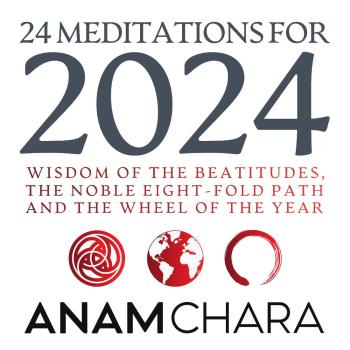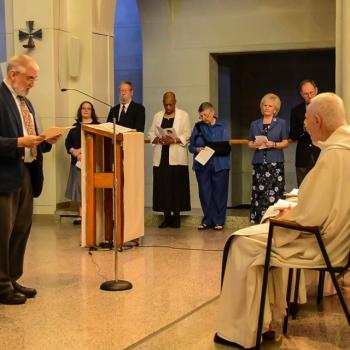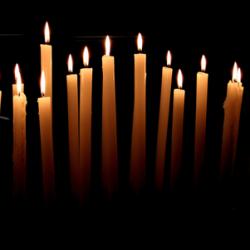
Nothing says “Catholic” quite as much as a rosary. But anyone — Catholic or Orthodox, Protestant or Pentecostal, Anglican or Evangelical — can find a way to incorporate the simple beauty of the rosary into the life of prayer. Think of a rosary as a tool, which can be used to foster contemplative silence or to train the subconscious into a life of habitual prayer and recollection (gathering the mind into a state of restful focus on God).
Mention the rosary, and I suspect most people think of a chain or cord with 59 beads, a crucifix and a medal of Mary or a saint. Go to your local Catholic store and you’ll see a colorful variety of rosaries, from glow-in-the-dark plastic ones (suitable for children) that cost less than a dollar, all the way up to beautiful rosaries featuring semi-precious or precious stones, silver chains and medals, costing in the hundreds of dollars.
But before you start figuring out the most expensive rosary you can afford, remember this: the chain is not really the “rosary” at all. It’s just the tool, a mnemonic device if you will, to assist you in praying the rosary. What is truly the rosary is the sequence of prayer and meditation that Christians have been praying to Christ and Mary for centuries.
I don’t need to go into details of how to pray the rosary; if you’re new to it, download this PDF for instructions. My purpose is simply to celebrate the rosary as a doorway into contemplation. But first I want to address the two most common objections raised against the rosary:
- It is repetitive. In Matthew 6:7 Christ warns his followers not to use “vain repetitions” (King James Version) when praying. Although modern translations like the New International Version or the New Revised Standard Version more accurately translate this as “babbling” or “empty phrases,” to many Christians, it remains a direct attack on the rosary and its use of prayers — particularly the Hail Mary — repeated over and over. But even if we go with the KJV translation, it’s important to note that Jesus criticized vain repetition — in other words, repetition with no meaning or value. Obviously, this does not apply to the rosary when used properly, for Christians over the centuries have found it a singularly meaningful tool for praying more deeply and intimately with God. If we believe we are not to use vain repetition in our prayer, thank God for the rosary, where repetitive prayer is filled with grace.
- It emphasizes devotion to Mary over devotion to Christ. True, the traditional Catholic rosary includes more than 50 Marian prayers, compared to only 6 recitations each of the Lord’s Prayer and the trinitarian Glory Be prayer. Although devotion to Mary has been a part of Orthodox, Catholic and Anglican devotion since the earliest days of the church, other Christians have not only abandoned Marian spirituality but actually oppose it as somehow un-Christian. This is not the place to solve that argument; all I can say is that Christians who venerate Mary understand the difference between worship (for God alone) and devotion (for those who love God). Meanwhile, to Christians who are uncomfortable with the Marian dimension of the rosary, I’d encourage you to explore alternative ways to use the rosary, such as Robert Llewelyn’s wonderful “Christ-centered rosary” found on pages 136 and 137 of his book With Pity Not With Blame. There’s nothing magical about the traditional rosary; other prayers can be substituted that can still enable you to use the rosary as a tool for fostering contemplation.
How is the rosary a tool for contemplation? When you pray the rosary, you are engaging your conscious mind on several levels. First and most simply, the drone of the recited prayers serves to suppress the incessant “chatter” of normal waking consciousness. By itself, though, even a formula for reciting repetitive prayers can be overpowered by the mind’s ability to distract itself.
But the rosary involves more than just praying by rote.
The rosary beads require attention as you move your fingers across the beads in accord with the progression of the prayers; and throughout the rosary, mysteries — significant events from the life of Christ or Mary — are to be meditated on while you recite the prayers. To the beginner, this seems overwhelming: remember all the prayers, the manipulation of the beads, and a mystery to meditate on simultaneously!
But it doesn’t take long for the power and spiritual beauty of the rosary to be revealed: for in this “multi-tasking” approach to prayer, the tight control of normal waking consciousness is turned back on itself. In essence, by praying the rosary, you give the ego so much to do that its ability to undermine your prayer with distracting thoughts is minimized, if not done away with altogether.
And while you consciously engage your devotional awareness on these multiple levels, you are in essence freeing up deeper regions of our soul to simply rest in the Divine Presence — the essential heart of contemplation.
Not everyone will find the rosary useful or enjoyable. Spiritual seekers with a more naturally apophatic (imageless) inclination, who naturally find joy and comfort in the profound emptiness of contemplative meditation, may find the rosary to be busy, even frenetic. If you don’t enjoy the rosary on a conscious level, you may not allow yourself to experience the subtle contemplative benefits that it affords at deepers levels.
But for those whose spiritual personality leans more toward kataphatic, or image-based, meditation, the vivid imagery and symbolism of the prayers and mysteries of the rosary can bring joy in themselves, as well as the unexpected benefit of nurturing a deep sense of stillness and grounding in the changeless stability of God.
The moral of this story is as simple as it is evident: if you don’t care for the rosary, find other disciplines for your prayer life; but if you do enjoy, pray it with delight… and be mindful of how it nurtures you, not only consciously but on a deep soul-level as well.
For further reading:
- Christianica Center, The Scriptural Rosary
- Mary K. Doyle, The Rosary Prayer by Prayer
- Benedict J. Groeschel, C.F.R., The Rosary: Chain of Hope
- Liz Kelly, The Rosary: A Path into Prayer
- Robert Llewelyn, A Doorway to Silence: The Contemplative Use of the Rosary
- Kathryn Marcellino, How to Pray the Rosary as a Pathway to Contemplation
- Teresa Rhodes McGee, Mysteries of the Rosary in Ordinary Life
- M. Basil Pennington, Praying by Hand: Rediscovering the Rosary As a Way of Prayer
- M. Basil Pennington, 20 Mysteries of the Rosary: A Scriptural Journey
- Sr. Patricia Proctor, ed., 101 Inspirational Stories of the Rosary
- Garry Wills, The Rosary
Enjoy reading this blog?
Click here to become a patron.














